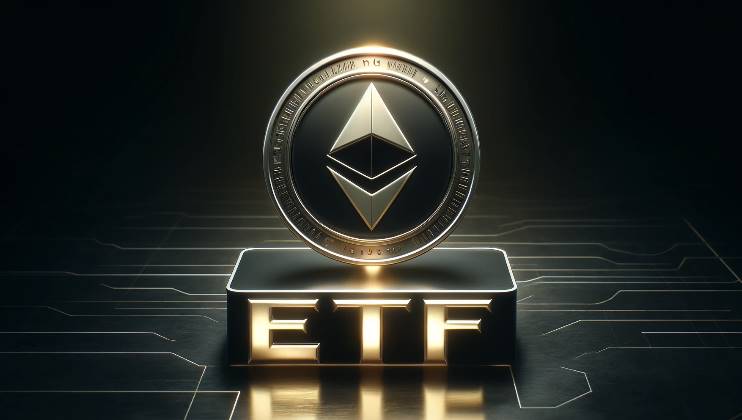
In one of the most perplexing market disconnects of 2025, Ethereum is experiencing an unprecedented paradox that has left both institutional investors and retail traders scratching their heads. Despite spot Ethereum ETFs recording their second-largest single-day inflows in history at $729.1 million on August 13, ETH prices have struggled to maintain momentum, currently trading around $4,300, well below the psychological $5,000 barrier that many analysts expected to be breached by now.
This extraordinary market contradiction reveals a fundamental shift in how institutional capital flows are impacting cryptocurrency price discovery. Ethereum ETF inflows reached $2.3 billion in August 2025, yet the underlying asset has failed to respond with the explosive price action that historical patterns would suggest. The disconnect between institutional demand and price performance represents one of the most significant anomalies in cryptocurrency market structure since the launch of Bitcoin ETFs.
1. Record-Breaking Institutional Demand: The Numbers That Don’t Add Up
The magnitude of institutional investment flowing into Ethereum ETFs has reached levels that dwarf initial market expectations, creating a compelling narrative of institutional adoption that should, in theory, be driving substantial price appreciation. However, the reality of price action has diverged dramatically from these fundamental indicators.
1.1 Historic ETF Inflow Surge Defies Market Logic
On August 13, 2025, spot Ethereum ETFs saw $729.1 million flow into the products, marking their second-largest inflows on record and demonstrating institutional appetite that exceeds even Bitcoin ETF performance during comparable periods. This single-day inflow figure represents more than the entire market capitalization of many top-50 cryptocurrencies, highlighting the sheer scale of institutional interest in Ethereum exposure.
The week surrounding this record inflow was equally impressive, with cumulative flows reaching extraordinary levels. The inflows were led by $1.02 billion on Monday, followed by $523.92 million on Tuesday and $729.14 million on Wednesday, creating a three-day period that saw more than $2.2 billion in institutional investment. This short burst of buying not only matched but exceeded the previous weekly record of $2.12 billion set in mid-July, establishing a new benchmark for institutional Ethereum adoption.
What makes these figures particularly remarkable is their consistency and sustainability. Unlike the initial rush into Bitcoin ETFs, which showed more volatile inflow patterns, Ethereum ETF demand has demonstrated remarkable consistency, suggesting that institutional investors are making strategic, long-term allocation decisions rather than engaging in tactical trading. Cumulative net inflows into Ethereum ETFs have now surpassed $12.1 billion, supported by over $4.47 billion in trading volume, indicating deep and sustained institutional commitment to the asset.
1.2 BlackRock’s Unprecedented ETH Accumulation Strategy
Leading the institutional charge has been BlackRock’s ETHA ETF, which recorded $500.85 million in inflows on August 13 alone, representing nearly 70% of the day’s total ETF inflows. This concentration of institutional interest in BlackRock’s offering reflects the asset manager’s sophisticated approach to cryptocurrency investing and its ability to attract institutional capital from traditional finance sectors.
BlackRock’s Ethereum strategy has been particularly notable for its scale and consistency. Record institutional buying, including BlackRock’s 150,000 ETH purchase, has fueled what should be bullish sentiment as Ethereum ETFs serve as a bridge between traditional and crypto markets. The acquisition of 150,000 ETH represents approximately $615 million in underlying asset purchases at current prices, demonstrating the real economic impact of ETF flows on Ethereum’s supply dynamics.
1.3 Corporate Treasury Adoption Accelerates
Beyond ETF flows, direct corporate adoption of Ethereum has accelerated throughout August 2025, with companies like Bitmine and SharpLink diversifying their portfolios by investing in ETH. These companies could be on the early side of an institutional adoption wave, according to recent analysis, suggesting that corporate treasury adoption may follow patterns similar to Bitcoin’s corporate acceptance cycle.
The corporate adoption trend represents a particularly bullish fundamental development, as treasury allocations typically involve longer holding periods and more strategic thinking than trading-oriented institutional investments. Companies adopting Ethereum for treasury purposes are essentially making bets on the long-term viability and appreciation potential of the asset, creating natural supply constraints that should support higher prices.
2. The Great Disconnect: When Fundamentals Meet Market Reality
The stark contrast between record institutional inflows and lackluster price performance represents one of the most significant market anomalies in cryptocurrency history. This disconnect challenges traditional assumptions about how institutional capital flows translate into price discovery and raises fundamental questions about market efficiency in the digital asset space.
2.1 Price Performance Lags Institutional Conviction
Despite the unprecedented level of institutional investment, Ethereum has struggled to break through key resistance levels that technical analysts have identified as crucial for the next phase of the bull market. The cryptocurrency’s failure to sustainably trade above $4,500 despite record ETF inflows suggests that other market forces are overwhelming the positive impact of institutional demand.
This performance gap becomes more striking when compared to historical precedents. During similar periods of institutional Bitcoin accumulation, price responses were typically immediate and substantial, with Bitcoin often gaining 20-30% within weeks of major institutional adoption announcements. Ethereum’s muted response to even larger relative institutional flows suggests that the market structure for ETH may be fundamentally different or that countervailing forces are neutralizing institutional buying pressure.
The disconnect is particularly puzzling given that Ethereum ETFs have demonstrated superior performance metrics compared to Bitcoin ETFs during equivalent periods. In their launch week in January 2024, Bitcoin ETFs recorded $655 million in net inflows on their strongest day, while Ethereum’s $1.02 billion record on August 11 and $729.1 million on August 13 both exceeded that figure. This suggests unusually rapid uptake among institutional and retail investors that should theoretically translate into price appreciation.
2.2 Market Structure Evolution Creates New Dynamics
The current disconnect may reflect fundamental changes in cryptocurrency market structure that are altering how institutional flows impact price discovery. As institutional participation has increased, traditional patterns of supply and demand may be giving way to more complex dynamics that include hedging activities, arbitrage trading, and sophisticated risk management strategies that weren’t present in earlier market cycles.
Institutional investors entering through ETFs may be simultaneously engaging in hedging activities in derivatives markets that partially offset their spot market impact. This sophisticated approach to cryptocurrency exposure allows institutions to gain economic exposure while managing volatility risk, but it also means that ETF inflows don’t translate directly into spot buying pressure as markets have historically expected.
The maturation of cryptocurrency derivatives markets has also created new mechanisms through which institutional demand can be expressed and hedged. Options markets, futures contracts, and other derivative instruments provide institutions with tools to manage their cryptocurrency exposure in ways that may not directly impact spot prices, creating more complex relationships between institutional interest and price performance.
2.3 Liquidity Paradox and Market Efficiency Questions
The current market environment raises important questions about liquidity and market efficiency in cryptocurrency markets. Despite record institutional inflows, trading volumes and market depth don’t appear to be responding in ways that would traditionally support sustained price appreciation. This suggests that the relationship between institutional demand and market liquidity may be more complex than previously understood.
One potential explanation for the disconnect lies in the nature of ETF operations and how they interact with underlying cryptocurrency markets. ETF creation and redemption mechanisms may be creating more efficient arbitrage opportunities that prevent significant premium or discount development, but they may also be dampening the direct price impact of institutional flows through sophisticated market-making activities.
The efficiency of modern cryptocurrency markets may actually be working against the type of explosive price moves that characterized earlier institutional adoption cycles. As markets mature and become more efficient, the impact of large flows may be more quickly arbitraged away, leading to more stable but less dramatic price responses to fundamental developments.
3. Market Psychology: Why Good News Isn’t Working
The current disconnect between positive institutional developments and price performance reflects complex market psychology dynamics that demonstrate how investor sentiment can override fundamental factors in the short term. Understanding these psychological factors is crucial for predicting when and how the fundamental-technical disconnect might resolve.
3.1 Institutional vs Retail Sentiment Divergence
One of the most significant factors contributing to the current market anomaly is the apparent divergence between institutional and retail investor sentiment. While institutional investors are allocating record amounts of capital to Ethereum through ETFs, retail sentiment remains cautious following previous market volatility and macroeconomic uncertainty.
This sentiment divergence creates a complex market dynamic where institutional demand provides fundamental support while retail selling pressure or lack of buying enthusiasm prevents explosive price moves. Retail investors, who have historically been responsible for the momentum-driven phases of cryptocurrency bull markets, may be waiting for clearer technical signals before committing capital to new positions.
3.2 Fear of Missing Out vs Fear of Losing More
The current market environment presents investors with conflicting psychological pressures that may be contributing to the price-fundamental disconnect. Record institutional inflows create fear of missing out (FOMO) among some market participants, while persistent macroeconomic uncertainty and previous market volatility create fear of additional losses among others.
This psychological conflict results in a market where both buying and selling pressures remain relatively balanced, preventing the type of unidirectional moves that would typically accompany record institutional adoption. Investors are simultaneously attracted by the fundamental strength demonstrated by institutional inflows and concerned about the macroeconomic factors that could derail cryptocurrency markets.
The resolution of this psychological conflict will likely determine when and how the current disconnect between fundamentals and price action resolves. If institutional inflows continue while macroeconomic concerns diminish, the psychological balance could shift toward FOMO-driven buying. Conversely, if macroeconomic concerns intensify, even strong institutional demand may be insufficient to drive sustained price appreciation.
3.3 Changing Market Participant Behavior Patterns
The maturation of cryptocurrency markets has altered traditional behavioral patterns that previously created more direct relationships between fundamental developments and price action. Institutional investors bring different behavioral patterns and investment approaches that may be dampening the explosive price responses that characterized earlier market cycles.
Institutional investors typically employ more sophisticated risk management approaches, including hedging strategies and position sizing methodologies that may partially offset their spot market impact. This sophisticated approach creates more stable but less dramatic market responses to fundamental developments, altering the traditional boom-bust patterns that characterized earlier cryptocurrency markets.
The changing composition of market participants also affects how information is processed and incorporated into prices. As institutional participation increases, market efficiency improves, but this efficiency may actually reduce the magnitude of price responses to fundamental developments as arbitrage opportunities are more quickly identified and exploited.
4. The Staking Revolution: Ethereum’s Hidden Value Proposition
One crucial factor that may be contributing to the current price-inflow disconnect is the evolution of Ethereum’s staking ecosystem, which creates unique dynamics that don’t exist in Bitcoin markets. The ability to stake Ethereum and earn yield fundamentally alters the investment equation and may be influencing how institutional capital flows translate into price action.
4.1 ETF Staking Capabilities Transform Investment Calculus
Unlike Bitcoin ETFs, which hold non-yielding assets, Ethereum ETFs have the potential to incorporate staking rewards, fundamentally changing the value proposition for institutional investors. While not all Ethereum ETFs currently offer staking rewards to shareholders, the technological capability exists and represents a significant competitive advantage that could drive continued institutional adoption.
The prospect of earning staking rewards through ETF ownership creates additional incentives for institutional investment beyond simple price appreciation. For institutional investors with fiduciary responsibilities, the ability to earn yield while maintaining exposure to Ethereum’s price appreciation potential represents a compelling risk-adjusted return profile that could sustain institutional demand even during periods of price consolidation.
4.2 Supply Dynamics and Network Security Implications
The growth in Ethereum staking, accelerated by institutional ETF adoption, is creating significant changes in the cryptocurrency’s supply dynamics that may not be immediately reflected in price action but could have substantial long-term implications. As more ETH becomes locked in staking contracts, the circulating supply available for trading diminishes, theoretically creating upward pressure on prices.
Current estimates suggest that approximately 28% of total ETH supply is locked in staking contracts, with this percentage continuing to grow as institutional adoption increases. The addition of ETF-driven institutional staking could accelerate this trend, potentially creating supply scarcity that supports higher prices over longer time horizons even if short-term impact is muted.
The network security implications of increased staking also create positive feedback loops that enhance Ethereum’s fundamental value proposition. Higher staking participation increases network security and decentralization, making the network more attractive for enterprise and institutional use cases that could drive additional demand for ETH over time.
4.3 Yield Competition with Traditional Assets
The yield potential of staked Ethereum creates a unique competitive dynamic with traditional fixed-income assets that may be influencing institutional allocation decisions. Current Ethereum staking yields of approximately 3-4% compare favorably with many government bond yields while offering additional potential for capital appreciation, creating a compelling alternative for institutional fixed-income allocations.
This yield competition may be attracting institutional capital from traditional fixed-income mandates rather than speculative cryptocurrency allocations, potentially creating more stable and less momentum-driven demand patterns. Institutional investors approaching Ethereum as a yield-generating asset may have different holding periods and trading behaviors than those viewing it purely as a speculative investment.
5. DeFi Integration: The Institutional On-Chain Revolution
One of the most significant but underappreciated aspects of current institutional Ethereum adoption is the growing integration with decentralized finance protocols, which creates additional utility and demand drivers that extend well beyond simple investment exposure. This institutional DeFi adoption represents a paradigm shift that may be altering traditional relationships between capital flows and price action.
5.1 Institutional Yield Farming and Protocol Integration
Sophisticated institutional investors are increasingly utilizing Ethereum-based DeFi protocols to enhance yields on their ETH holdings, creating additional demand for the underlying asset while generating revenue streams that improve the risk-adjusted return profile of their cryptocurrency allocations. This institutional DeFi adoption creates sustained demand for ETH beyond simple investment holding purposes.
Institutional yield farming strategies often involve complex protocols and smart contract interactions that require significant ETH holdings to optimize gas efficiency and maintain adequate liquidity buffers. These operational requirements create additional demand for ETH that scales with the sophistication and size of institutional DeFiparticipation, potentially creating substantial hidden demand that doesn’t appear in traditional flow analysis.
5.2 Tokenization and Real-World Asset Integration
Institutional adoption of Ethereum has been significantly driven by the platform’s capabilities for tokenizing real-world assets, including real estate, commodities, and financial instruments. This tokenization trend creates substantial demand for ETH as gas for smart contract operations and as collateral for various tokenization protocols.
The tokenization market represents one of the fastest-growing segments of the Ethereum ecosystem, with institutional investors using the platform to create more efficient and transparent investment structures for traditional asset classes. This trend creates sustained operational demand for ETH that grows with the scale of tokenization activities rather than simple investment speculation.
Real-world asset tokenization also attracts institutional investors who might not otherwise consider cryptocurrency exposure, as it allows them to utilize blockchain technology for operational efficiency while maintaining exposure to familiar asset classes. This adoption pathway creates additional demand for ETH from institutional segments that might not participate in pure cryptocurrency investment strategies.
5.3 Cross-Chain Infrastructure and Institutional Integration
The development of cross-chain infrastructure built on Ethereum has created new institutional use cases that require significant ETH holdings for operational purposes. As institutional investors utilize these infrastructure solutions for portfolio management and operational efficiency, they create sustained demand for ETH that extends beyond investment considerations.
Institutional cross-chain operations often require maintaining ETH balances across multiple protocols and chains to ensure operational continuity and optimal execution. These operational requirements create relatively stable demand for ETH that’s less sensitive to price movements and more focused on utility and efficiency considerations.
6. Market Structure Evolution: How Institutional Adoption Changes Everything
The massive institutional adoption of Ethereum through ETFs and other investment vehicles is fundamentally altering cryptocurrency market structure in ways that may explain why traditional relationships between capital flows and price action no longer apply as predictably as in previous market cycles.
6.1 Price Discovery Mechanisms Undergo Transformation
The introduction of large-scale institutional investors with sophisticated trading strategies and risk management approaches has changed how price discovery occurs in Ethereum markets. Rather than the momentum-driven price action that characterized earlier cryptocurrency markets, institutional participation has created more efficient but less volatile market dynamics.
Institutional investors often employ algorithmic trading strategies, hedging programs, and systematic rebalancing approaches that create more consistent but less dramatic market responses to fundamental developments. These sophisticated trading approaches may be dampening the extreme price movements that historically accompanied major adoption milestones while creating more stable long-term appreciation trends.
6.2 Liquidity Provision and Market Making Evolution
Institutional adoption has attracted professional market makers and liquidity providers who employ sophisticated strategies to profit from bid-ask spreads and arbitrage opportunities. While this increased liquidity provision improves market efficiency and reduces transaction costs, it may also dampen the price impact of large institutional flows through more efficient arbitrage mechanisms.
Professional market makers often hedge their cryptocurrency exposures through derivatives markets, creating complex cross-market relationships that may offset some of the direct price impact of institutional spot market transactions. This hedging activity improves market stability but may reduce the immediate price response to institutional adoption flows.
6.3 Correlation Dynamics and Risk Management Integration
Institutional Ethereum adoption has altered correlation dynamics between cryptocurrency markets and traditional assets, as institutional investors often manage their cryptocurrency exposures within broader portfolio contexts that include traditional asset hedging strategies. These correlation changes create more complex market relationships that may obscure direct connections between institutional flows and cryptocurrency prices.
Institutional risk management approaches often involve hedging cryptocurrency exposures through traditional assets or derivatives, creating cross-asset relationships that can offset or amplify cryptocurrency price movements depending on broader market conditions. These sophisticated risk management strategies may be contributing to more complex and less predictable relationships between institutional adoption and price action.
7. Trading Implications: How to Navigate the New Reality
The current disconnect between institutional Ethereum adoption and price performance creates unique trading opportunities and challenges that require sophisticated approaches to capitalize on the evolving market structure while managing the risks associated with fundamental-technical disconnects.
7.1 MEXC’s Advanced Tools for Institutional-Grade Trading
MEXC provides institutional-quality trading infrastructure that enables sophisticated strategies for navigating the current market environment, including advanced order types, deep liquidity pools, and comprehensive risk management tools that are essential for trading in institutionally-dominated markets.
The exchange’s sophisticated matching engine and order management systems provide the speed and reliability necessary for implementing complex trading strategies that can capitalize on the inefficiencies created by the current fundamental-technical disconnect. These capabilities are particularly important in markets where institutional algorithms and high-frequency trading strategies are increasingly prevalent.
MEXC’s comprehensive derivative offerings, including perpetual futures, options, and structured products, provide traders with the tools necessary to implement hedging strategies and express complex views about the relationship between institutional adoption and price action. These derivatives capabilities enable more sophisticated risk management and profit potential than spot trading alone.
7.2 Strategic Approaches for the Current Environment
The current market environment favors trading strategies that can capitalize on the disconnect between strong fundamentals and weak price action while managing the risks associated with uncertain timing of resolution. MEXC’s platform enables implementation of sophisticated strategies including calendar spreads, volatility trading, and mean reversion approaches that can profit from the current market anomaly.
Institutional-grade strategies such as dollar-cost averaging, systematic rebalancing, and volatility targeting can help traders capture value from the current fundamental strength while managing the uncertainty around timing of price response. These approaches mirror institutional investment strategies and may be better suited to the current market structure than traditional momentum-based approaches.
Advanced traders can utilize MEXC’s cross-margin capabilities and portfolio margining to implement complex multi-asset strategies that hedge Ethereum exposure against broader market risks while maintaining upside exposure to potential resolution of the fundamental-technical disconnect. These sophisticated approaches require professional-grade infrastructure like that provided by MEXC.
7.3 Risk Management in Uncertain Market Conditions
The current market environment necessitates sophisticated risk management approaches that account for the possibility that traditional relationships between fundamentals and price action may not apply in institutionally-dominated markets. MEXC’s comprehensive risk management tools provide the capabilities necessary for navigating these complex conditions.
Position sizing and leverage management become particularly important in markets where strong fundamentals may not translate immediately into price appreciation, requiring traders to maintain sufficient capital and time horizon to capture value when market disconnects eventually resolve. MEXC’s flexible leverage options and margin requirements support these sophisticated risk management approaches.
Diversification strategies that include both directional and relative value components can help traders capture opportunities from the current market structure while managing the risks associated with uncertain timing and magnitude of price responses to fundamental developments. MEXC’s broad product offering enables implementation of these diversified approaches within a single platform.
Disclaimer: This content is for educational and reference purposes only and does not constitute any investment advice. Digital asset investments carry high risk. Please evaluate carefully and assume full responsibility for your own decisions
Join MEXC and Get up to $10,000 Bonus!
Sign Up


